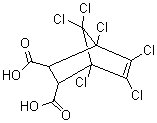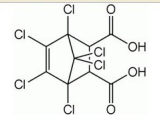- Category :
Intermediates
- CAS NO : 115-28-6
- EC NO : 204-078-9
- Molecular Formula : C9H4Cl6O4
- Main Specifications : 99%
- Synonyms : 1,4,5,6,7,7-hexachloro-8,9,10-trinorborn-5-ene-2,3-dicarboxylic acid;1,4,5,6,7,7-hexachlorobicyclo(2.2.1)hept-5-ene-2,3-dicarboxylic acid;Chloroendic Acid;1,4,5,6,7,7-bicyclo[2.2.1]-5-heptene-2,3-dicarboxylic acid;1,4,5,6,7,7-bicyclo[2.2.1]hept-5-ene-2,3-dicarboxylic acid;1,4,5,6,7,7-hexachloro-5-norbornene-2,3-dicarboxylic acid;1,4,5,6,7,7-Hexachlorobicyclo(2.2.1)-5-heptene-2,3-dicarboxylic acid;1,4,5,6,7,7-hexachlorobicyclo[2.2.1]hept-5-ene-2,3-dicarboxylic acid;het acid;hexachloroendomethylenetetrahydrophthalic acid;(1R,2S,3R,4S)-1,4,5,6,7,7-hexachlorobicyclo[2.2.1]hept-5-ene-2,3-dicarboxylic acid;
Package: 25KGS/ Bags, 500KGS/Bag
Uses : flame-resistant composites for building and transportation
Molecular Structure:

Product description:
Chlorendic acid is industrially produced in high volumes by Diels-Alder reaction. It is used as an intermediate in synthesis of unsaturated flame-retardant polyester resins and plasticizers, and as a finishing flame-retardant treatment for wool. A major use is in production of fiberglass-reinforced resins for chemical industry equipment. It can be used to make alkyd resins for use in special inks and paints. It is used as a hardening agent in epoxy resins used in manufacture of printed circuit boards. When reacted with nonhalogenated glycols, it forms halogenated polyols used as flame retardants in polyurethane foams. it is also used for production of dibutyl chlorendate and dimethyl chlorendate, which are used as reactive flame retardants in plastics. In limited amounts, it is used as an additive in acrylonitrile butadiene styrene copolymer.
Esters and amine salts of chlorendic acid are used as extreme pressure additives in synthetic lubricants.
When used in polymers, whether as a curing agent or as a flame retardant, it bonds covalently to the polymer matrix, which reduces its leaching to the environment. It may, however, be released when such materials are subjected to hydrolysis, and can be formed by oxidation of chlorinated cyclodiene insecticides (eg. endosulfan, chlordane, heptachlor, aldrin, dieldrin, endrin, and isodrin). Its half-life in soil is 140-280 days.
In Europe, 80% of chlorendic acid is used in production of flame-resistant composites for building and transportation, the rest is used in materials for corrosion-resistant fluid storage equipment. In the USA, Latin America, and Asia, 20-30% is used in flame retardant applications and the rest is used in corrosion-resistant plastics.
